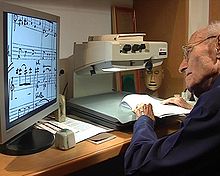Screen reader

A screen reader , camera reading system or obsolete television reader is an electronic visual aid . It records documents or other "small" things with a camera and reproduces them greatly enlarged on a monitor .
Screen readers are used by visually impaired people for whom reading large texts with optical visual aids is too cumbersome. This is the case at the latest when more than 8x optical magnification is required to recognize characters. Camera reading systems can also be useful when there is a need for increased contrast.
The object to be read (e.g. a document) is placed under a camera on a movable cross table that can be moved horizontally or vertically by hand. The recorded text excerpt is transferred to the screen in real time. Depending on the type of visual impairment, magnification, contrast and brightness can be varied. In addition, the text and background color can be selected on most devices. In this way, for example, color blindness can be partially compensated.
Screen readers can be used to read books, letters and other documents. But newspapers, package inserts, maps and bank statements can also be enlarged. If there is enough distance to the work surface, you can write or do manual work under the camera. Screen readers are available in different designs and for special purposes.
Device types for different usage situations
Basic version: Screen readers usually consist of the elements camera, monitor and cross table. The latter supports the guidance of the reading under the camera. Usually the camera and cross table are connected to one another, the monitor can be freely adjusted. These screen readers are usually easy to use and meet the needs of seniors.
Devices with PC connection: Camera systems that can be connected to a PC are used particularly in the work area. The captured image is then transferred to the computer monitor. Most devices allow screen sharing; H. the monitor display is divided into a PC and one or more camera images. Some devices with a PC connection have a scan function with which the imported templates can be saved and further processed. This also offers the possibility of having longer text read aloud via voice output.
Devices with remote cameras: The so-called board reading devices enlarge distant objects in the room, e.g. B. the blackboard at school. Either a swiveling camera or an additional remote camera is used for this.
Portable devices for use on the go: Portable screen readers are operated independently of the mains with batteries. Portable devices are usually equipped with a flat screen and handheld camera or are connected to a laptop and controlled via the keyboard.
Currently (as of 2012) the so-called electronic or digital magnifying glass is at the end of miniaturization . Here screen and camera (along with lighting, spacers, etc.) are combined in one device that is roughly the size of a cell phone. The electronic magnifying glass is by no means a substitute for a screen reader. Both types of device have their advantages and disadvantages.
Web links
- Product tests and detailed information on screen readers in INCOBS
- Screen readers in the REHADAT tools portal
